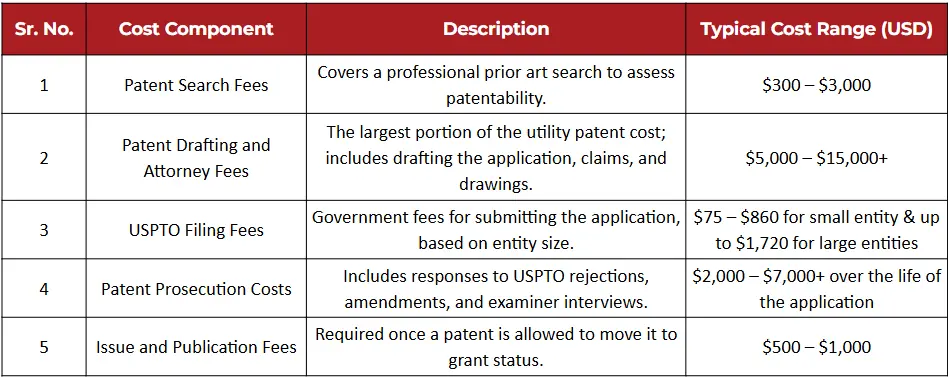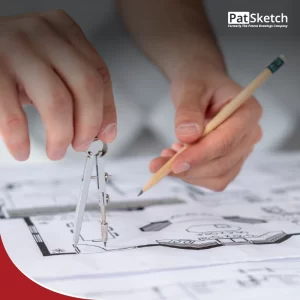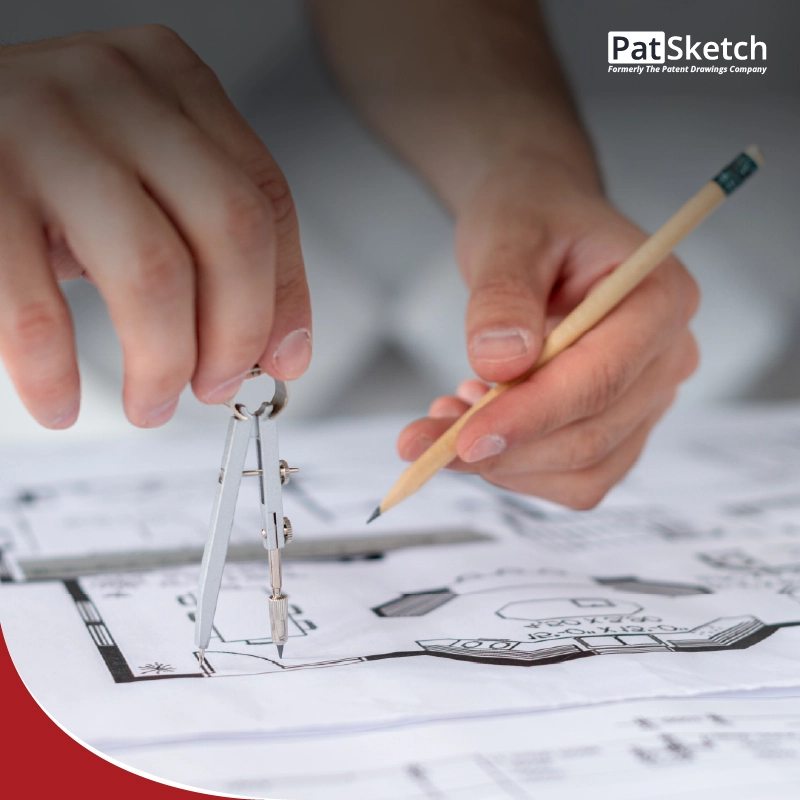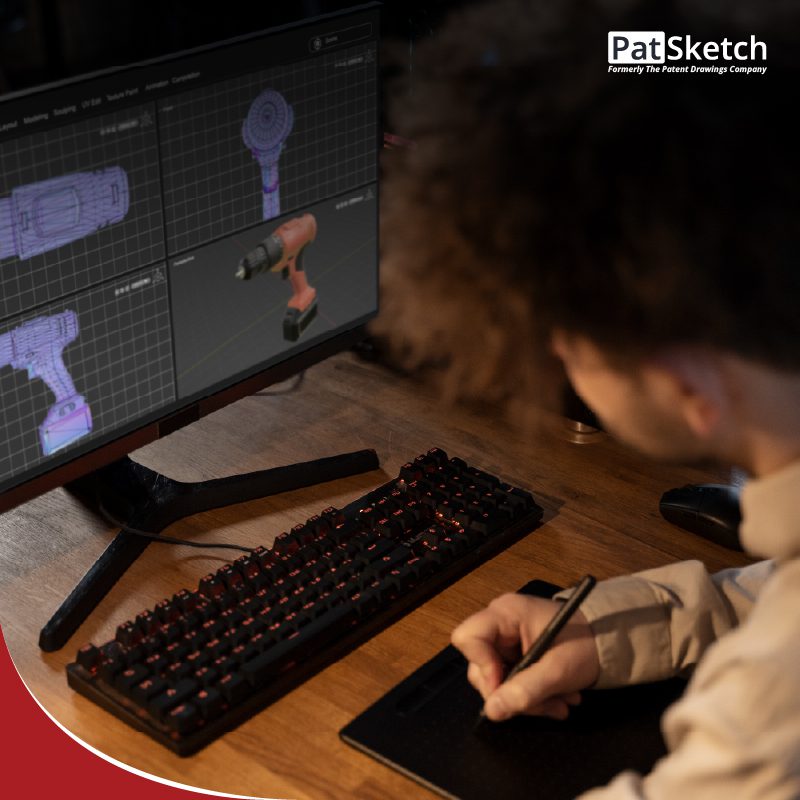Filing for a utility patent is a major step in protecting an invention, but it often involves a substantial financial commitment. In the U.S., the cost of a utility patent typically ranges from $7,000 to $30,000 or more, depending on the invention’s complexity and legal support needed.
According to the American Intellectual Property Law Association (AIPLA) 2023 Economic Survey, the cost to file a utility patent application of minimal complexity is about $7,500. For more complex inventions, that figure can climb to $10,000 or higher, excluding additional prosecution costs that may follow. These 2023 figures still serve as a reliable benchmark in 2025, as utility patent costs have remained relatively consistent over time.
In this blog, we’ll delve deeper into the components that influence utility patent cost, providing insights to help inventors and businesses budget effectively for the patenting process.
How Much Does a Utility Patent Cost?
Several key factors influence the cost of utility patent applications beyond just the base filing fees. One of the most significant is the complexity of the invention, as intricate designs typically demand more attorney time and detailed specifications, which can raise the cost considerably. The technical field also matters; fields like biotechnology or software often involve higher preparation costs due to specialized knowledge requirements.
Another variable is the jurisdiction of filing; international filings or those involving multiple countries may substantially increase the cost to file utility patent applications. Lastly, whether the applicant opts for a provisional or non-provisional application will impact both the immediate and long-term costs. Understanding these influences is crucial to estimating the overall investment required.
Factors Influencing Utility Patent Cost
Several elements contribute to the cost of utility patent applications, making it essential to understand what drives pricing variations:
Complexity of the Invention
The more intricate the invention, the higher the cost. While a straightforward invention might cost around $7,500, complex inventions, especially those with multiple embodiments or extensive claims, can push the cost to file a utility patent to $15,000 or more.
Technical Field
The industry or technology type plays a major role. For example, filing a patent in biotechnology or software can cost $10,000–$20,000, while simpler mechanical inventions may stay below $10,000, largely due to differences in drafting and legal review requirements.
Jurisdiction of Filing
Filing only in the U.S. keeps the process relatively affordable. However, seeking international protection under treaties like the PCT can increase the cost of utility patent protection significantly, sometimes adding $10,000–$20,000 per country over time.
Provisional vs. Non-Provisional Application
Filing a provisional application generally costs between $2,000 and $4,000, serving as a lower-cost entry point. However, the required follow-up non-provisional application typically ranges from $7,500–$15,000, depending on the invention and firm used.
Breakdown of Utility Patent Cost
Understanding where your money goes during the patent process helps you better plan for the total cost of utility patent protection. Below is a breakdown of the major cost components:

The total cost to file and maintain a utility patent over its lifetime can range from $10,000 to $30,000 or more, depending on complexity, legal involvement, and filing strategy.
Utility Patent Cost-Saving Strategies
Here are three effective strategies to help reduce the cost of filing a utility patent, along with insights on how each approach influences the overall filing and prosecution costs.
Filing a Provisional Patent Application
Filing a provisional application first is one of the most effective ways to lower the initial cost to file a utility patent. A provisional application is simpler and less expensive to prepare than a non-provisional one, often costing around $3,000 to $5,000, compared to $8,000 or more for a standard utility filing. It allows inventors to secure an early filing date and delay the full cost of prosecution for up to 12 months. This period can be used to evaluate market interest, seek funding, or refine the invention before committing to the full cost of a utility patent.
Using Small or Micro Entity Discounts
Qualifying for small or micro entity status can significantly reduce the cost. Small entities receive a 50% discount on most USPTO fees, while micro entities receive a 75% discount. These savings apply to key stages such as filing, examination, and maintenance.
For example, a standard utility filing fee of $320 may be reduced to $160 or even $80, depending on the entity status, leading to substantial long-term savings across the patent’s lifecycle. For startups, independent inventors, or academics, these discounts are a critical lever in managing.
Strategic Bundling of Related Inventions
When possible, bundling related inventions into a single utility patent application can help reduce the cost of utility patent filings. Instead of filing multiple separate applications, each with its own set of fees, one carefully drafted application can cover multiple aspects or embodiments of a broader invention.
This strategy lowers the total number of filings and associated attorney fees. However, it must be executed carefully to avoid restriction requirements from the USPTO, which could necessitate separate divisional applications. Done correctly, bundling can streamline the process and significantly reduce the total cost.
International Considerations for Utility Patent Cost
When pursuing patent protection internationally, the cost of utility patent filings varies significantly across jurisdictions. Here are the important factors that affect globally:
Cost Differences Across Jurisdictions
The cost to file utility patent applications internationally depends heavily on the country of filing. Filing a non-PCT patent application abroad costs a median of $1,000 per country, not including local fees. In contrast, filing a foreign-origin application in the U.S. costs about $1,200, showing how inbound and outbound filing costs differ.
Additional differences emerge during the amendment and maintenance phases. For example:
- Simple amendments abroad cost around $1,200 to $1,800
- More complex filings (biotech, electrical, mechanical) may range from $2,000 to $2,900, depending on the technical area and location.
PCT Filing Expenses
Filing under the Patent Cooperation Treaty (PCT) is a smart way to postpone filing in other countries while getting an early international filing date. The cost of utility patent filings under the PCT route includes:
- Filing a PCT application in the U.S. costs about $1,090.
- Entering the national stage in the U.S. from a PCT costs around $1,200.
- Entering the national stage in foreign jurisdictions from a U.S. PCT costs about $900 to $1,000 per country, varying by region.
The PCT process incurs initial costs but allows time to assess markets and investments before making full filings.
Foreign Filing Expenses
Beyond initial filing fees, foreign filing expenses include translation costs, agent fees, annuity payments, and amendment procedures. For instance:
- Paying annuities abroad typically costs $300, while in Europe the median is $328.
- Preparing and filing a U.S. origin application in Europe is around $1,000.
- Complex amendments through foreign counsel range from $2,000 to $2,900, depending on the technical complexity and region.
These expenses can significantly increase the total cost, especially when seeking protection in multiple countries.
Conclusion
Understanding the cost of utility patent is essential for inventors and businesses aiming to protect their innovations effectively. Exploring cost-saving strategies like provisional applications, small entity discounts, and strategic bundling can also make the process more manageable. For those seeking global protection, being aware of international filing and maintenance fees is equally important.
By preparing in advance and making informed decisions, applicants can maximize their patent investment while avoiding unnecessary expenses. A well-planned patent strategy lays the foundation for long-term competitive advantage and commercial success.
PatSketch for Expert Utility Patent Drawings Services
Navigating the patent process requires precision, especially when it comes to your application’s visual components. At PatSketch, we specialize in delivering high-quality utility patent drawings services that comply with USPTO and WIPO standards. Our experienced illustrators also offer top-notch design patent drawings services, ensuring your invention’s aesthetic aspects are accurately represented.
With our comprehensive patent drawings services, you can confidently present your innovations, knowing every detail is meticulously captured. Join over 4,000 satisfied clients who trust PatSketch for their patent illustration needs. Start your journey towards robust patent protection today.








